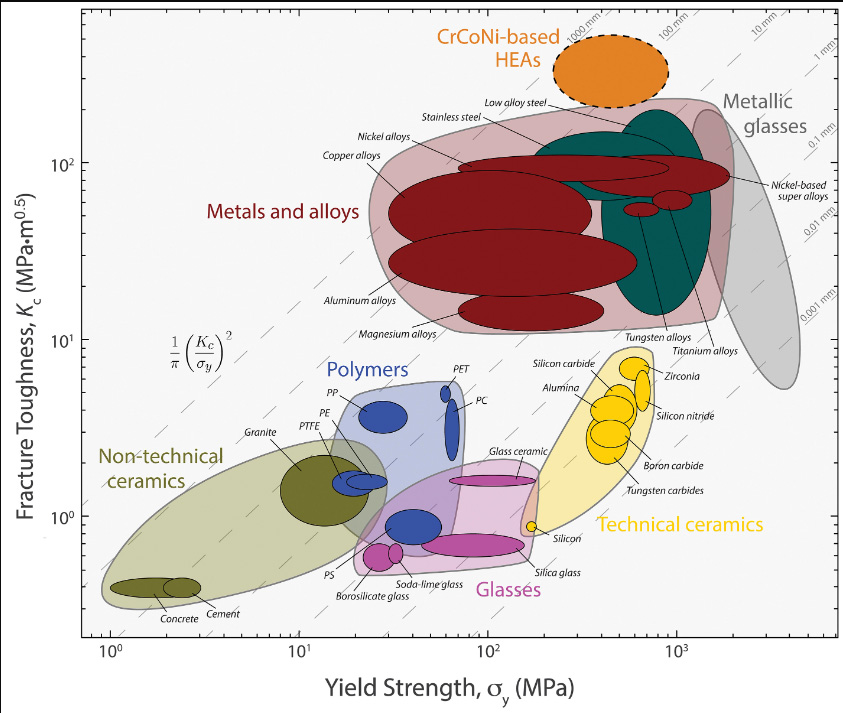A high entropy alloy with exceptional fracture toughness at extreme cryogenic temperatures, 20K. [View all]
I was directed to this paper by a news link on my email feed, this one: Toughest Known Material on Earth Discovered
The full paper to which the news item refers is here: Exceptional fracture toughness of CrCoNi-based medium- and high-entropy alloys at 20 kelvin, Dong Liu, Qin Yu, Saurabh Kabra, Ming Jiang, Paul Forna-Kreutzer, Ruopeng Zhang, Madelyn Payne, Flynn Walsh, Bernd Gludovatz, Mark Asta, Andrew M. Minor, Easo P. George, Robert O. Ritchie, Science 378, 6623, 978-983 (2022).
From the introduction to the full paper:
High-entropy alloys (HEAs) have attracted increasing attention in the metallurgy community as a class of metallic materials that derive their properties from the presence of multiple principal elements, rather than from a single dominant constituent as in most traditional metallic alloys (e.g., Fe in steels). Inspired by two seminal papers (1, 2), the field has grown to encompass equiatomic as well as nonequiatomic alloys, single-phase solid solutions, and multiphase compositionally complex alloys, with the goal of finding combinations of properties that differ from those of conventional alloys (3–7).
One prominent group of such materials are the single-phase, face-centered cubic (fcc), equiatomic alloys based on the CrCoNi system. Among these, the equiatomic CrMnFeCoNi alloy is the most characterized of all HEAs (1, 6–11). It came to prominence because its room-temperature strength and ductility can be substantially enhanced at liquid nitrogen temperature (8, 9) without compromising toughness (10). Moreover, its crack-initiation fracture toughness, KJIc, remained at roughly 220 MPa·m½ over the temperature range 293 to 77 K, with a crack-growth toughness, Kss, of >300 MPa·m½ (after 2.25 mm of crack extension) (10). More recent experiments on this HEA showed a similar increase in strength and toughness (the latter measured in terms of the absorbed deviatoric strain energy) when the strain rate was increased from 10−3 s−1 (quasistatic compression) up to extremely high rates of 6 × 105 s−1 (dynamic shear) (11).
There have been several derivatives of the CrMnFeCoNi alloy (12–14), most notably the single-phase equiatomic CrCoNi medium-entropy alloy (MEA), which displays even better properties. At 77 K, this MEA was found to have a KJIc of 273 MPa·m½ and a Kss exceeding 400 MPa·m½ (15). Although strength and toughness are often mutually exclusive properties (16), the CrCoNi alloy exhibits exceptionally high damage tolerance, with fracture toughness values among the largest ever reported. Such CrCoNi-based multiple principal element alloys are clearly strong candidate materials for potential applications in extreme environments, such as at very high strain rates and cryogenic temperatures...
Much of this paper is in the language of materials science, which I only speak in a Pidgeon form; my son is a materials scientist.
However I found this graphic to be most interesting:

The caption:
Fig. 5. Ashby map in terms of the fracture toughness, Kc, versus the yield strength, σy, for a broad class of materials.
Note the exceptional fracture toughness of the CrCoNi-based medium- and high-entropy alloys, which appear to be the highest on record. (The toughness results contained in this figure for materials other than the CrCoNi-based alloys were measured at ambient temperatures.) PC, polycarbonate; PE, polyethylene; PET, polyethylene terephthalate; PP, polypropylene; PS, polystyrene; PTFE, polytetrafluoroethylene.
Missing in this figure are the remarkable MAX phases, but it is illustrative.
Very cool...
